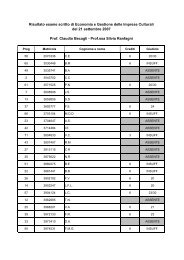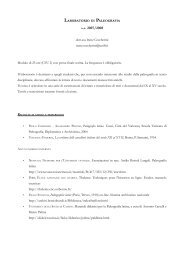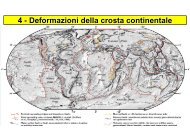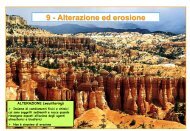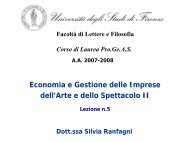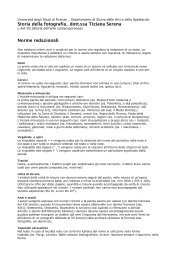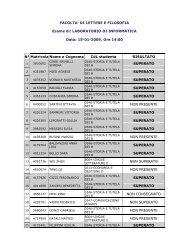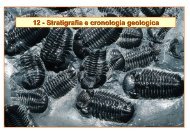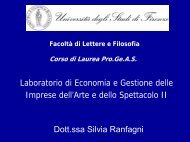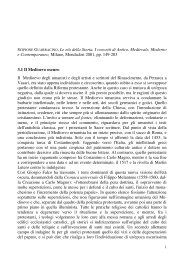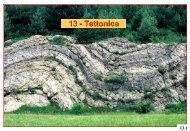Beyond Pragmatics. Morphosyntactic Development in Autism.pdf
Beyond Pragmatics. Morphosyntactic Development in Autism.pdf
Beyond Pragmatics. Morphosyntactic Development in Autism.pdf
Create successful ePaper yourself
Turn your PDF publications into a flip-book with our unique Google optimized e-Paper software.
J <strong>Autism</strong> Dev Disord<br />
<strong>in</strong>itiations, and the TD group produced more replies.<br />
The results <strong>in</strong>dicated that the autism group was more<br />
likely to produce atypical utterances that do not<br />
further the flow of conversation, although they are not<br />
less likely to engage <strong>in</strong> more typical ways as well.<br />
Another important element of the discourse analysis<br />
is to ask whether the adults across the three groups<br />
responded to or <strong>in</strong>itiated conversations differently.<br />
This could both affect children’s responses, and be the<br />
result of group differences <strong>in</strong> how children talk to the<br />
adults. Adult utterances were categorized <strong>in</strong>to<br />
the same categories as child utterances (see Table 5).<br />
Results showed a ma<strong>in</strong> effect of Category, and a<br />
Category · Group <strong>in</strong>teraction. Follow-up analyses<br />
<strong>in</strong>dicated a trend for a significant group effects <strong>in</strong><br />
Expansions, F(2, 44) = 2.63, p=.08, and Replies, F(2,<br />
44) = 2.72, p=.08. Post hoc analyses showed that the<br />
adults <strong>in</strong>teract<strong>in</strong>g with children <strong>in</strong> the autism group<br />
produced more expansions of their own utterances<br />
than for the DD group, t(29) = 2.18, p=.04, and fewer<br />
replies to the children’s utterances, t(29) = 2.11,<br />
p=.04.<br />
Previous work on discourse differences <strong>in</strong> autism<br />
(Curcio & Paccia, 1987) has shown that particular situational<br />
contexts as well as conversational partners can<br />
<strong>in</strong>fluence communicative skills <strong>in</strong> children with autism.<br />
Although an <strong>in</strong>-depth analysis of the moment-tomoment<br />
discourse context is beyond the scope of the<br />
present study, an assessment of a subset of five randomly-selected<br />
participants <strong>in</strong> each group demonstrated<br />
that most children spent the bulk of their time<br />
<strong>in</strong> play<strong>in</strong>g directly with toys [<strong>Autism</strong> group, Mean<br />
(SD) = .66 (.28); DD group, Mean (SD) = .85 (.14);<br />
TD group, Mean (SD) = .72 (.15)]. Groups did not<br />
differ on these measures, all p’s > .12.<br />
Cod<strong>in</strong>g of discourse categories was done by two<br />
<strong>in</strong>dependent raters (IME and MD), and 8% (n = 6) of<br />
the transcripts were coded by both raters. Inter-rater<br />
consistency was calculated at r = .923, with a net<br />
agreement of .887; v 2 (1) = 375.7, p < .001.<br />
Correlational Analyses<br />
To determ<strong>in</strong>e the relationships between non-verbal IQ,<br />
IPSyn scores, and <strong>in</strong>terrelationships among variables,<br />
the data were subjected to a planned series of correlational<br />
analyses, focus<strong>in</strong>g on with<strong>in</strong>-group correlations<br />
for the ASD participants to reduce Type I errors; see<br />
Table 6.<br />
Syntactic ability (IPSyn score) was correlated with<br />
other language measures across the entire sample,<br />
<strong>in</strong>clud<strong>in</strong>g lexical abilities (PPVT-III, Type-token<br />
ratio), and pragmatic abilities (Ignor<strong>in</strong>g; Expansions).<br />
Although correlational data cannot determ<strong>in</strong>e causality,<br />
this f<strong>in</strong>d<strong>in</strong>g is consistent with the suggestion that<br />
hav<strong>in</strong>g stronger syntactic abilities facilitates one’s<br />
acquisition of new words, as well as one’s ability to<br />
participate more effectively <strong>in</strong> <strong>in</strong>teractions.<br />
Interest<strong>in</strong>gly, the production of jargon was negatively<br />
correlated with NVIQ, with IPSyn score, with<br />
lexical measures (PPVT-III and Type-Token Ratio),<br />
and with discourse function<strong>in</strong>g (Ignore), suggest<strong>in</strong>g<br />
that jargon is l<strong>in</strong>ked both to language ability as a whole<br />
as well as to cognitive function<strong>in</strong>g.<br />
The conceptual ability to discuss non-present<br />
objects, people, or events, seemed to be a languagespecific<br />
ability. It was not correlated with non-verbal<br />
IQ, r (48) = .15, p > .3, but was correlated with IPSyn,<br />
r (48) = .29, p < .05, and with the production of jargon,<br />
r (48) = –.39, p < .01, computed across all subjects.<br />
Table 5 Discourse characteristics<br />
<strong>Autism</strong> M (SD) DD M (SD) TD M (SD) Group differences<br />
Interactive<br />
Child <strong>in</strong>itiation** .068 (.036) .14 (.075) .083 (.058) DD > TD**, Aut**<br />
Adult <strong>in</strong>itiation .074 (.037) .062 (.037) .062 (.033)<br />
Child reply** .60 (.18) .570 (.15) .74 (.13) TD > DD**, Aut*<br />
Adult replyà .46 (.16) .59 (.16) .51 (.17) Aut < DD*<br />
Child expansion* .15 (.097) .23 (.13) .14 (.10) DD > TD*, Aut*<br />
Adult expansionà .44 (.14) .33 (.16) .41 (.13) Aut > DD*<br />
Discourse <strong>in</strong>terrupt<strong>in</strong>g<br />
Child echo*** .06 (.036) .026 (.026) .019 (.02) Aut > TD**, DD**<br />
Adult echo .027 (.025) .02 (.016) .014 (.013)<br />
Child ignore*** .046 (.032) .014 (.015) .013 (.013) Aut > TD***, DD***<br />
Adult ignore .0021 (.0043) .0028 (.0048) .0008 (.002)<br />
Child un<strong>in</strong>terpretable** .058 (.078) .014 (.012) .007 (.013) Aut > DD**, TD**<br />
Adult un<strong>in</strong>terpretable .0003 (.0013) .0001 (.0005) .0004 (.0011)<br />
Note: Figures represent rates of occurrences of the given discourse type per total number of turns (e.g., possible occurrences)<br />
à p < .10, * p < .05, ** p < .01, *** p < .001<br />
123


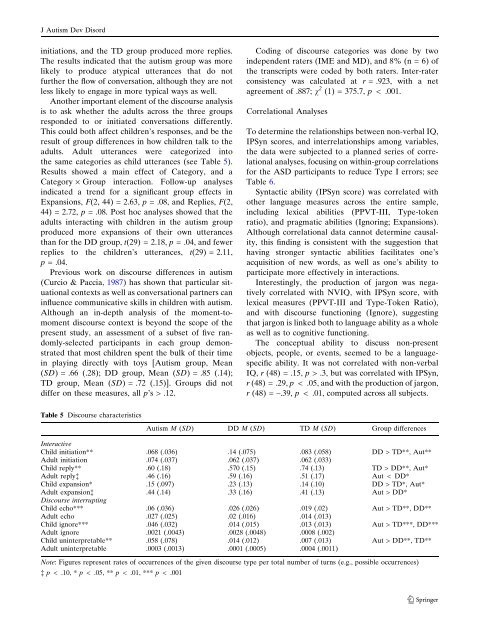
![PATROLOGIA GRECA E LATINA [Patrologiae cursus completus]. All ...](https://img.yumpu.com/50711133/1/184x260/patrologia-greca-e-latina-patrologiae-cursus-completus-all-.jpg?quality=85)
